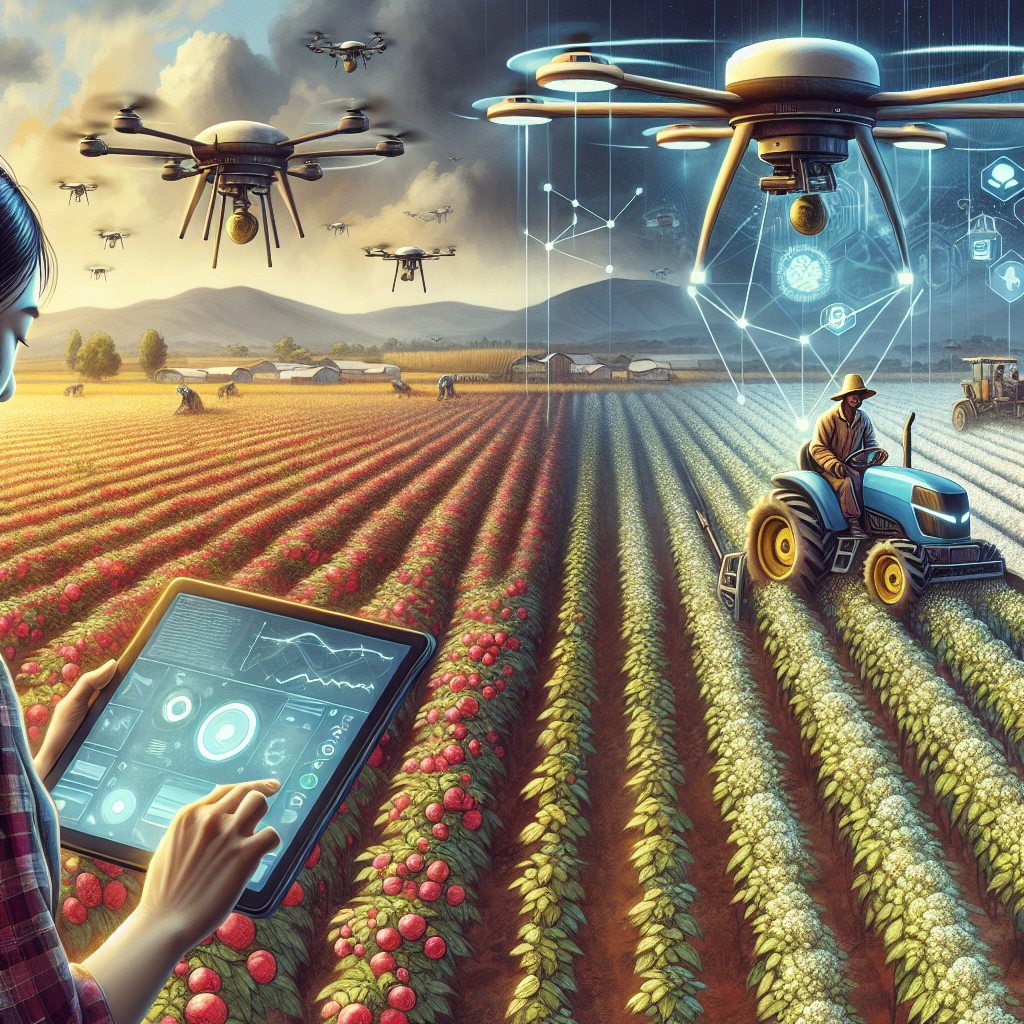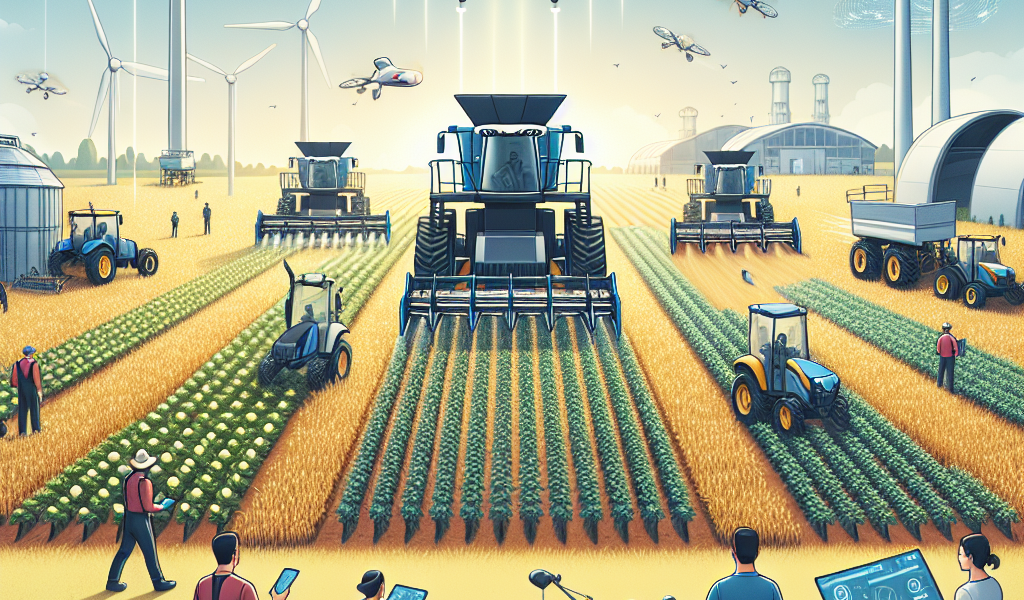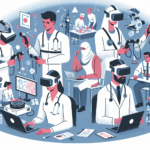-
Table of Contents
“Revolutionizing Harvests: The Future of Farming with Cutting-Edge Technology”
Introduction

Technology is revolutionizing agricultural practices by enhancing efficiency, productivity, and sustainability. Precision agriculture, utilizing GPS and IoT, allows farmers to monitor and manage crops with unprecedented accuracy, optimizing resource use and reducing waste. Drones and satellite imagery provide real-time data on crop health, enabling timely interventions. Advanced machinery and automation streamline planting, harvesting, and maintenance, reducing labor costs and increasing yield. Biotechnology, including genetically modified organisms (GMOs) and CRISPR, improves crop resilience and nutritional value. Additionally, data analytics and machine learning offer predictive insights, helping farmers make informed decisions. Collectively, these technological advancements are transforming agriculture, ensuring food security and promoting environmental stewardship.
Precision Farming: Enhancing Crop Yields with Advanced Technology
In recent years, the agricultural sector has witnessed a remarkable transformation, largely driven by the advent of precision farming. This innovative approach leverages advanced technology to enhance crop yields, optimize resource use, and ultimately, ensure sustainable farming practices. As the global population continues to grow, the demand for food production intensifies, making the role of precision farming more crucial than ever.
One of the most significant advancements in precision farming is the use of GPS technology. By integrating GPS with farming equipment, farmers can achieve unparalleled accuracy in planting, fertilizing, and harvesting crops. This precision not only maximizes the efficiency of field operations but also minimizes waste, ensuring that every inch of farmland is utilized to its fullest potential. For instance, GPS-guided tractors can follow exact paths, reducing overlap and ensuring even distribution of seeds and fertilizers. This level of precision translates to higher crop yields and lower input costs, benefiting both the farmer and the environment.
In addition to GPS, the rise of drones has revolutionized the way farmers monitor their fields. Equipped with high-resolution cameras and sensors, drones can capture detailed images of crops, providing valuable insights into plant health, soil conditions, and pest infestations. These aerial surveys allow farmers to identify issues early and take targeted action, preventing minor problems from escalating into major setbacks. Moreover, drones can cover large areas quickly, offering a comprehensive view of the farm that would be impossible to achieve through traditional methods. This bird’s-eye perspective is instrumental in making informed decisions that enhance crop productivity.
Another critical component of precision farming is the use of data analytics. Modern farms generate vast amounts of data from various sources, including weather stations, soil sensors, and machinery. By harnessing the power of big data, farmers can analyze trends, predict outcomes, and make data-driven decisions. For example, soil sensors can provide real-time information on moisture levels, enabling farmers to optimize irrigation schedules and conserve water. Similarly, weather data can help predict the best times for planting and harvesting, reducing the risk of crop failure due to adverse conditions. This data-centric approach ensures that resources are used efficiently, leading to higher yields and lower environmental impact.
Furthermore, advancements in biotechnology have also played a pivotal role in precision farming. Genetically modified crops, designed to withstand pests and diseases, have significantly reduced the need for chemical pesticides. This not only lowers production costs but also promotes a healthier ecosystem. Additionally, biotechnology has led to the development of crops with enhanced nutritional profiles, addressing food security and malnutrition issues in many parts of the world. By combining genetic advancements with precision farming techniques, farmers can produce more resilient and nutritious crops, meeting the demands of a growing population.
The integration of artificial intelligence (AI) and machine learning into farming practices is another exciting development. AI-powered systems can analyze data from various sources and provide actionable insights, helping farmers make better decisions. For instance, AI algorithms can predict pest outbreaks based on historical data and current conditions, allowing farmers to take preventive measures. Machine learning models can also optimize planting patterns and crop rotations, ensuring that the soil remains fertile and productive over the long term. These intelligent systems are transforming agriculture into a more precise and efficient industry.
In conclusion, precision farming represents a significant leap forward in agricultural practices, driven by the integration of advanced technologies such as GPS, drones, data analytics, biotechnology, and artificial intelligence. These innovations are not only enhancing crop yields but also promoting sustainable farming practices that are essential for feeding a growing global population. As technology continues to evolve, the future of agriculture looks promising, with precision farming leading the way towards a more efficient and sustainable food production system.
Drones in Agriculture: Revolutionizing Crop Monitoring and Management
In recent years, the agricultural sector has witnessed a technological revolution that is transforming traditional farming practices. Among the most groundbreaking innovations are drones, which are increasingly being used to monitor and manage crops with unprecedented precision. These flying marvels are not just a novelty; they are becoming indispensable tools for farmers seeking to optimize their yields and ensure sustainable practices.
Drones, or unmanned aerial vehicles (UAVs), are equipped with advanced sensors and imaging capabilities that allow them to capture detailed aerial views of farmland. This bird’s-eye perspective provides farmers with critical insights that are difficult, if not impossible, to obtain from the ground. For instance, drones can quickly survey large areas, identifying variations in crop health, soil conditions, and irrigation needs. This rapid assessment enables farmers to make informed decisions, addressing issues before they escalate into significant problems.
One of the most significant advantages of using drones in agriculture is their ability to perform precise crop monitoring. Traditional methods of crop inspection are labor-intensive and time-consuming, often requiring farmers to walk through fields and manually check plant health. In contrast, drones can cover vast expanses of land in a fraction of the time, capturing high-resolution images that reveal subtle differences in plant coloration and growth patterns. These images can be analyzed using specialized software to detect signs of disease, pest infestations, or nutrient deficiencies. By identifying these issues early, farmers can take targeted actions, such as applying pesticides or fertilizers only where needed, thereby reducing costs and minimizing environmental impact.
Moreover, drones are revolutionizing irrigation management. Water is a precious resource, and efficient irrigation is crucial for sustainable farming. Drones equipped with thermal cameras can detect variations in soil moisture levels, helping farmers to identify areas that require more or less water. This data-driven approach to irrigation ensures that crops receive the optimal amount of water, promoting healthy growth while conserving resources. Additionally, drones can monitor the effectiveness of irrigation systems, identifying leaks or blockages that might otherwise go unnoticed.
The benefits of drones extend beyond crop monitoring and irrigation. They are also being used for precision planting and seeding. Traditional planting methods can be imprecise, leading to uneven crop distribution and wasted resources. Drones, however, can be programmed to drop seeds at specific locations and depths, ensuring uniform planting and maximizing the chances of successful germination. This precision planting technique not only improves crop yields but also reduces the need for replanting, saving time and money.
Furthermore, drones are playing a crucial role in data collection and analysis. The information gathered by drones can be integrated with other technologies, such as GPS and Geographic Information Systems (GIS), to create detailed maps and models of farmland. These digital tools enable farmers to visualize their fields in new ways, identifying trends and patterns that inform long-term planning and decision-making. For example, farmers can use these maps to design more efficient planting strategies, optimize crop rotation schedules, and plan for future expansion.
As the agricultural sector continues to embrace technology, the role of drones is likely to expand even further. Innovations such as artificial intelligence and machine learning are being integrated with drone technology, enabling even more sophisticated analysis and automation. These advancements promise to make farming more efficient, sustainable, and profitable, benefiting not only farmers but also the broader community.
In conclusion, drones are revolutionizing crop monitoring and management, offering farmers a powerful tool to enhance productivity and sustainability. By providing detailed insights into crop health, soil conditions, and irrigation needs, drones are helping to usher in a new era of precision agriculture. As technology continues to evolve, the potential for drones in agriculture is boundless, promising a future where farming is smarter, more efficient, and more environmentally friendly.
Smart Irrigation Systems: Optimizing Water Usage for Sustainable Farming
In recent years, the agricultural sector has witnessed a remarkable transformation, largely driven by advancements in technology. Among these innovations, smart irrigation systems have emerged as a game-changer, optimizing water usage and promoting sustainable farming practices. As the global population continues to grow and climate change exacerbates water scarcity, the importance of efficient water management in agriculture cannot be overstated. Smart irrigation systems, leveraging cutting-edge technology, are addressing these challenges head-on, ensuring that farmers can produce more with less.
One of the key components of smart irrigation systems is the integration of sensors and Internet of Things (IoT) devices. These sensors, strategically placed throughout the fields, continuously monitor soil moisture levels, weather conditions, and crop health. By collecting real-time data, these devices provide farmers with invaluable insights into the precise water needs of their crops. This data-driven approach allows for more accurate and timely irrigation, reducing water wastage and ensuring that plants receive the optimal amount of water for their growth.
Moreover, smart irrigation systems often incorporate weather forecasting technology. By analyzing weather patterns and predicting rainfall, these systems can adjust irrigation schedules accordingly. For instance, if a significant amount of rain is expected, the system can delay or reduce irrigation, conserving water and preventing overwatering. This not only saves water but also helps in maintaining the health of the crops, as overwatering can lead to root diseases and other issues.
Another significant advantage of smart irrigation systems is their ability to be controlled remotely. Through mobile apps or web platforms, farmers can monitor and manage their irrigation systems from anywhere in the world. This remote accessibility is particularly beneficial for large-scale farms, where manually checking and adjusting irrigation systems can be time-consuming and labor-intensive. With just a few clicks, farmers can ensure that their crops are receiving the right amount of water, even if they are miles away from their fields.
Furthermore, smart irrigation systems contribute to sustainable farming by promoting the efficient use of resources. Traditional irrigation methods, such as flood or sprinkler irrigation, often result in significant water loss due to evaporation, runoff, and deep percolation. In contrast, smart irrigation systems, such as drip irrigation, deliver water directly to the root zone of the plants, minimizing water loss and maximizing efficiency. This targeted approach not only conserves water but also reduces the energy required for pumping and distributing water, thereby lowering the overall carbon footprint of farming operations.
In addition to water conservation, smart irrigation systems also have economic benefits for farmers. By optimizing water usage, these systems can lead to significant cost savings on water bills. Moreover, healthier crops resulting from precise irrigation can lead to higher yields and better-quality produce, translating into increased revenue for farmers. In a world where profit margins in agriculture are often slim, these financial advantages can make a substantial difference.
As we look to the future, the role of smart irrigation systems in sustainable farming is likely to become even more critical. With ongoing advancements in technology, these systems are expected to become more sophisticated, affordable, and accessible to farmers of all scales. By embracing smart irrigation, the agricultural sector can take a significant step towards ensuring food security, conserving precious water resources, and mitigating the impacts of climate change.
In conclusion, smart irrigation systems represent a pivotal innovation in modern agriculture. By harnessing the power of technology, these systems optimize water usage, promote sustainable farming practices, and offer economic benefits to farmers. As we continue to face global challenges related to water scarcity and food production, the adoption of smart irrigation systems will undoubtedly play a crucial role in shaping the future of agriculture.
Conclusion
Technology is significantly enhancing agricultural practices by increasing efficiency, productivity, and sustainability. Precision agriculture, utilizing GPS and IoT, allows for more accurate planting, watering, and harvesting, reducing waste and optimizing resource use. Drones and satellite imagery provide real-time data for monitoring crop health and soil conditions, enabling timely interventions. Automation and robotics streamline labor-intensive tasks, reducing human error and labor costs. Biotechnology, including genetically modified organisms (GMOs), improves crop resilience and yields. Additionally, data analytics and machine learning offer predictive insights for better decision-making. Overall, technology is transforming agriculture into a more efficient, sustainable, and productive industry.





